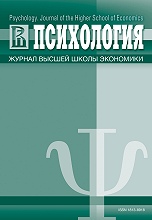Валидизация русскоязычной версии опросника этических позиций
Аннотация
В статье представлены результаты валидизации русскоязычной версии опросника этических позиций Д. Р. Форсайта (Ethics Position Questionnaire). Оригинальная версия опросника содержит два ортогональных фактора (Идеализм и Релятивизм), на основе которых составлена таксономия этических позиций (ситуационизм, абсолютизм, субъективизм и эксепционизм). В статье высказано предположение, что идеализм и релятивизм следует рассматривать как поведенческие диспозиции. В настоящем исследовании при помощи конфирматорного факторного анализа проверены несколько теоретических моделей. КФА показал, что наибольшей пригодностью обладает двухуровневая структурная модель, в которой идеализм и релятивизм являются ортогональными факторами второго порядка. При этом идеализм включает в себя такие факторы, как Недопущение вреда (И1) и Забота о благе (И2), а релятивизм – Относительность этических систем (Р1), Межличностный релятивизм (Р2) и Допустимость лжи (Р3). Полученная модель обладает рядом преимуществ. Во-первых, она полностью соответствует теоретической модели Д. Р. Форсайта, включая ортогональность основных факторов. Во-вторых, она предполагает многомерность конструктов «идеализм» и «релятивизм». В третьих, позволяет согласовать между собой результаты предыдущих эмпирических исследований. Также в исследовании установлено, что EPQ имеет хорошую внутреннюю согласованность, ретестовую надежность, конвергентную, дискриминантную и номологическую валидность. Последняя оценивалась в рамках номологической сети, в которой идеализм и релятивизм были соотнесены с конструктами, связанными с ценностной системой человека (в рамках теории базовых индивидуальных ценностей Ш. Шварца). Полученные результаты позволяют считать русскоязычную версию EPQ надежным и валидным инструментом оценки идеализма и релятивизма.
Скачивания
Литература
2. Campbell, D. R., & Fiske, D. W. (1959). Convergent and discriminant validation by the multitraitmultimethod matrix. Psychological Bulletin, 56(2), 81-105.
3. Cui, C. C., Mitchell, V., Schlegelmilch, B. B., & Cornwell, B. (2005). Measuring consumers' ethical position in Austria, Britain, Brunei, Hong Kong, and USA. Journal of Business Ethics, 62(1), 57- 71. https://doi.org/10.1007/s10551-005-8501-7
4. Davis, M. A., Andersen, M. G., & Curtis, M. B. (2001). Measuring ethical ideology in business ethics: A critical analysis of the Ethics Position Questionnaire. Journal of Business Ethics, 32(1), 35-53. https://doi.org/10.1023/A:1010701417165
5. Douglas, P. C., & Wier, B. (2005). Cultural and ethical effects in budgeting systems: A comparison of U.S. and Chinese managers. Journal of Business Ethics, 60(2), 159-174. https://doi.org/10.1007/s10551-004-6711-z
6. Dunn, T. J., Baguley, T., & Brunsden, V. (2014). From alpha to omega: A practical solution to the pervasive problem of internal consistency estimation. British Journal of Psychology, 105(3), 399- 412. https://doi.org/10.1111 /bjop.12046
7. Eysenck, H. J., Barrett, P., Wilson, G., & Jackson, C. (1992). Primary trait measurement of the 21 components of the P-E-N system. European Journal of Psychological Assessment, 8(2), 109-117.
8. Fedorov, A. A. (2007). Stil' v psikhologii: dekonstruktsiia termina [Style in psychology: Deconstruction of the term]. Vestnik Novosibirskogo Gosudarstvennogo Universiteta. Seriya Psikhologiya, 1(1), 26-31. (in Russian)
9. Fornell, C., & Larcker, D. F. (1981). Evaluating structural equation models with unobservable variables and measurement error. Journal of Marketing Research, 18(1), 39-50. https://doi.org/10.2307/3151312
10. Forsyth, D. R. (1980). A taxonomy of ethical ideologies. Journal of Personality and Social Psychology, 39(1), 175-184. https://doi.org/10.1037/0022-3514.39.1. 175
11. Forsyth, D. R., O'Boyle, E. H., & McDaniel, M. A. (2008). East meets West: A meta-analytic investigation of cultural variations in idealism and relativism. Journal of Business Ethics, 83(4), 813-833. https://doi.org/10.1007/s10551-008-9667-6
12. Geldhof, G. J., Preacher, K. J., & Zyphur, M. J. (2014). Reliability estimation in a multilevel confirmatory factor analysis framework. Psychological Methods, 19(1), 72-91.
13. Hair, J. F., Black, W. C., Babin, B. J., & Anderson, R. E. (2014). Multivariate data analysis. Harlow, UK: Pearson Education Limited. Hermida, R. (2015). The problem of allowing correlated errors in structural equation modeling: concerns and considerations. Computational Methods in Social Sciences (CMSS), 3(1), 5-17.
14. Hu, L., & Bentler, P. M. (1999). Cutoff criteria for fit indexes in covariance structure analysis: Conventional criteria versus new alternatives. Structural Equation Modeling: A Multidisciplinary Journal, 6(1), 1-55. https://doi.org/10.1080/10705519909540118
15. Karande, K., Rao, C. P., & Singhapakdi, A. (2002). Moral philosophies of marketing managers: A comparison of American, Australian, and Malaysian cultures. European Journal of Marketing, 36(7/8), 768-791. https://doi.org/10.1108/03090560210430791
16. Khanin, Yu. L. (1976). Shkala Marlou-Krauna dlya issledovaniya motivatsii odobreniya. Metodicheskoe pis'mo [Marlowe-Crowne Social Desirability Scale]. Leningrad: NII fizicheskoi kul'tury. (in Russian)
17. Kornilova, T. V., Kornilov, S. A., Chumakova, M. A., & Talmach, M. S. (2015). The Dark Triad personality traits measure: approbation of the Dirty Dozen Questionnaire. Psikhologicheskii Zhurnal, 36(2), 99-112. (in Russian)
18. Kurtines, W. M. (1984). Moral behavior as rule-governed behavior: A psychosocial role-theoretical approach to moral behavior and development. In Morality, moral behavior, and moral development (pp. 149-194). New York: Wiley.
19. Lemeshko, B. Yu., & Lemeshko, S. B. (2008). Ob ustoichivosti i moshchnosti kriteriev proverki odnorodnosti srednikh [On the stability and power of criteria for checking the homogeneity of means]. Izmeritel'naia Tekhnika, 9, 23-28. (in Russian)
20. Marsh, H. W., Hau, K.-T., & Wen, Z. (2004). In search of Golden Rules: Comment on hypothesistesting approaches to setting cutoff values for fit indexes and dangers in overgeneralizing Hu and Bentler's (1999) findings. Structural Equation Modeling: A Multidisciplinary Journal, 11(3), 320- 341. https://doi.org/10.1207/s15328007sem1103_2
21. Norman, G. (2010). Likert scales, levels of measurement and the 'laws' of statistics. Advances in Health Sciences Education, 15(5), 625-632. https://doi.org/10.1007/s10459-010-9222-y
22. Paulhus, D. L. (1991). Measurement and control of response bias. In J. P. Robinson, P. R. Shaver, & L.S. Wrightsman (Eds.), Measures of social psychological attitudes (Vol. 1, pp. 17-59).
23. San Diego, CA: Academic Press. Pelaez, M. (2001). Morality as a system of rule-governed behavior and empathy. Behavioral Development Bulletin, 10(1), 8-14. https://doi.org/10.1037/h0100475
24. Redfern, K. (2004). An empirical investigation of the Ethics Position Questionnaire in the People's Republic of China. Journal of Business Ethics, 50(3), 199-210. https://doi.org/10.1023/B:BUSI.0000024741.85399.0d
25. Revelle, W., & Zinbarg, R. E. (2008). Coefficients Alpha, Beta, Omega, and the glb: Comments on Sijtsma. Psychometrika, 74(1), 145-154. https://doi.org/10.1007/s11336-008-9102-z





